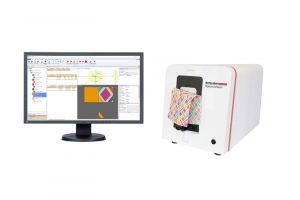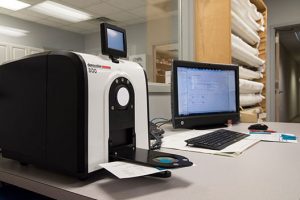Activewear and performance fabrics offer a myriad of challenges that make it difficult to effectively measure, formulate and replicate color from design through production. From sheerness and open fabric structures that make measurement challenging, to color formulation considerations related to product performance and metamerism/flare, there are a lot of nuances that need to be considered.
When tackling any of these color concerns for activewear or performance fabrics, be sure to consider the following essential items.
Measurement Technique
Traditional solid-colored fabrics are measured using a spectrophotometer as part of well-established color management processes. However, some activewear and performance fabrics present unique challenges that prevent using traditional tools or workflow. Take, for example, performance fabrics with open structures, like mesh, or complex compositions like heather. Or consider the various components that go into a complete garment, such as a jacket with buttons, zipper and cords.
Not that long ago, there was no technology capable of measuring either of these textile scenarios or the additional non-textile components that go into a complete garment. Thankfully, hyperspectral imaging has been introduced to the textile industry and new hyperspectral spectrophotometers can measure essentially any material a company is producing — effectively eliminating what was once known as “the unmeasurables” within the industry.
The ability to objectively measure every material as part of the color management process is particularly important, but those measurements must be compatible whether using traditional color measurement or hyper-spectral imaging. When one can measure something, not only is the color development timeline decreased significantly, but costs also are reduced. This a very exciting development for performance fabrics and the textile industry at large.
Color Formulation
When it comes to color matching, feasibility considerations are often top of mind. Color formulation software helps facilitate the shade matching process by using a sample’s reflectance curve to produce a dye formula that meets the desired color expectations. This process is used throughout the textile industry as it reduces the need for back and forth visual color evaluation and helps avoid scenarios where color development is worked on for several weeks only to learn the process needs to be started over again.
 Colorant Limitations
Colorant Limitations
Part of the color formulation process involves taking colorant limitations into consideration. Consider once again the athletic jacket with zippers, buttons and cords. When thinking holistically about that complete garment, colorant limitations come into play.
This is because the colorants available for the plastic zipper are quite different from those available for textiles. With textiles, on has a number of dye options available that increase the likelihood of achieving the exact shade you want. Not so much on the plastics side of things, where the colorant options are more limited. The challenge here is to match both materials so they look good without limiting the designer too severely.
Even when considering just the textiles, there are still colorant limitations. For example, a bright fluorescent shade may be available for cotton, but you can’t match it on polyester. Or perhaps it can be achieved, but it doesn’t have the wash fastness or another necessary performance characteristics.
The key here is to understand these characteristics, so one can determine what can be best achieved across these needs and still have a marketable product. It’s not just measuring the color, but understanding the ability of colors to work on these specialty fabrics in terms of color feasibility.
Fastness
Colorants also have specific performance capabilities that need to be considered as part of the color formulation process. For example, performance fabrics and athleticwear often have an elevated need for wash and light fastness. Since these textiles are exposed to sweat as well as significant amounts of natural daylight, they need high fastness properties, so the garment won’t fade over the seasons or bleed with sweating.
Colorant selection is essential to ensuring the end product performs to the expected degree. For both wash and light fastness, specific grayscale tests can be performed instrumentally to evaluate fading from light exposure or from bleeding that transfers dye to another material as a result of washing or sweating. Measuring fastness results with a spectrophotometer greatly improves accuracy and data collection compared to the subjective visual process of fastness evaluation.
 Metamerism And Flare
Metamerism And Flare
Another performance consideration tied to colorant selection has to do with sample color change in various lighting conditions. Athleticwear purchased in store — often under LED lighting — also needs to look equally good, with similar shade properties, in natural outdoor lighting. This isn’t a given, as metamerism — when colors match under one lighting condition but not under another — and flare — when the color of a material changes when it is viewed under different light sources — can greatly impact consumer perception of an end product across different lighting scenarios.
If the end product was intended to be part of a coordinating or matching set of goods, these color discrepancies could be disastrous. With multi-sourced programs or multi-component products, issues with metamerism and flare must be identified early in the color development process to prevent these problems from showing up in the final product.
It’s important to understand how some combinations of colorants may flare less — or flare in different directions — under changing light sources. Metamerism and flare can be detrimental to your product quality and consumer perception, but can be predicted and accounted for with instrumental color measurement and computer color formulation. Customers expect consistency and associate this with the quality of goods. Variations in color are one of the first quality characteristics consumers pick up on.
When it comes to color management for activewear and performance fabrics, there are additional nuances and considerations that should be kept top of mind. With the right tools in hand and the appropriate processes implemented, it’s possible to effectively and efficiently manage color for any textile category, including activewear and performance fabrics.
Editor’s Note: Ken Butts By Ken Butts is a global key account team manager at Datacolor, Lawrenceville, N.J. Butts has more than 25 years of experience as a solutions consultant in the textile and apparel industry. While with Datacolor, he has analyzed existing product development processes and implemented effective color management solutions for more than 40 of the world’s most well-known retail/brand apparel companies and their global supply chains.
June 25, 2020





